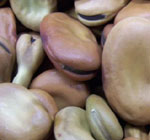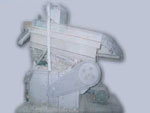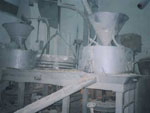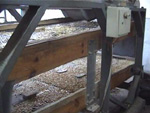
|
1-The raw broad beans:
The Egyptian raw broad bean has many unique characteristics and
advantages which are not found in any other kind of bean of any
country .this helps in producing high levels of quality of grind
beans.
The characteristics are classified as follow:
A-Moisture degree:
As the Egyptian bean is characterized with median moisture
degree, as the high one does not help in splitting operation and lead
to high amount of broken bean which make the final production of
bean bad
Moreover, the beans with low moisture degree is very dry,
can not be subject to the splitting operation and can be broken to
small pieces when it is put under the grind stones
Also, the moderate moisture degree saves the product, and this
facilitate the process of storing it for long periods without
destruction.
B-the grain volume , shape and size:
The Egyptian bean is very thick which facilitate the process of
splitting . It also has various sizes suitable for all tastes
once
its size is between 6 to 16 millimeter.
C-Purity:
There are no dirt in the Egyptian bean that can hardly be
removed or can badly affect the grinding machine or the
consumer, even if a little amount of it found like pebbles ajnd
solid stones.
The mentioned above shows why the Egyptian bean is considered as
a standard raw material for producing split broad beans.
|
 |
2-Cleaning up phase:
It is considered the first phase at which 3 machines are used.
The first one is to remove the heavy dirt, the second to remove
the light dirt and the third one to remove dusts.
|
 |
|
|
|
3-The grading production phase:
In this phase, pierced and graded cylinders are used to grade
the beans to six degrees according to its size/shape in order to
unify the grain volume to prepare it for the next splitting process.
|
 |
|
|
|
4-Splitting phase (removing the outer
shells):
This phase takes place trough grinding product in dry once it can not be wetted, soaked or washed with water(split
beans can be quickly destroyed and can not be stored for a long
period if it is mixed with water).
In this process, grinders made from the sculptured granite are
used in a special way which facilitate the process of removing
the outside shells quickly.
|
 |
|
|
|
5-Extracting Lobes:
This phase takes place by using a sieve with
different sizes of holes in order to separate the lobes from the
powder
beans and broken pieces. This sieve is also provided with
ventilator to draw the shells and then collected in a separate
sailos.
|
 |
|
|
|
6-Primary sifting:
Through this phase, all the lobes is passed on sieves to
advance it gradually to related and unified sizes in order to
prepare it for the cleaning process.
|
 |
|
|
|
7-Cleaning up:
This phase is made manually and in finely in order to protect
the product from being brokened. The trained workers can
remove the dirt that found in the lobes. |
 |
|
|
|
8-Re-sifting and cleaning
up:
Through this phase, product is passed for grading it
again in order to make sure that the size is fine. At the same
time, it is passed again on the workers who revise the cleaning
process to verify hand selection.
|
 |
|
|
|
9-Packing:
This phase is made automatically and in metal silo. The weight
of bags is controlled automatically. Product can be
packed in sacks weighted 25 or 50 k( or any other weight
requested by the client).
|
 |

